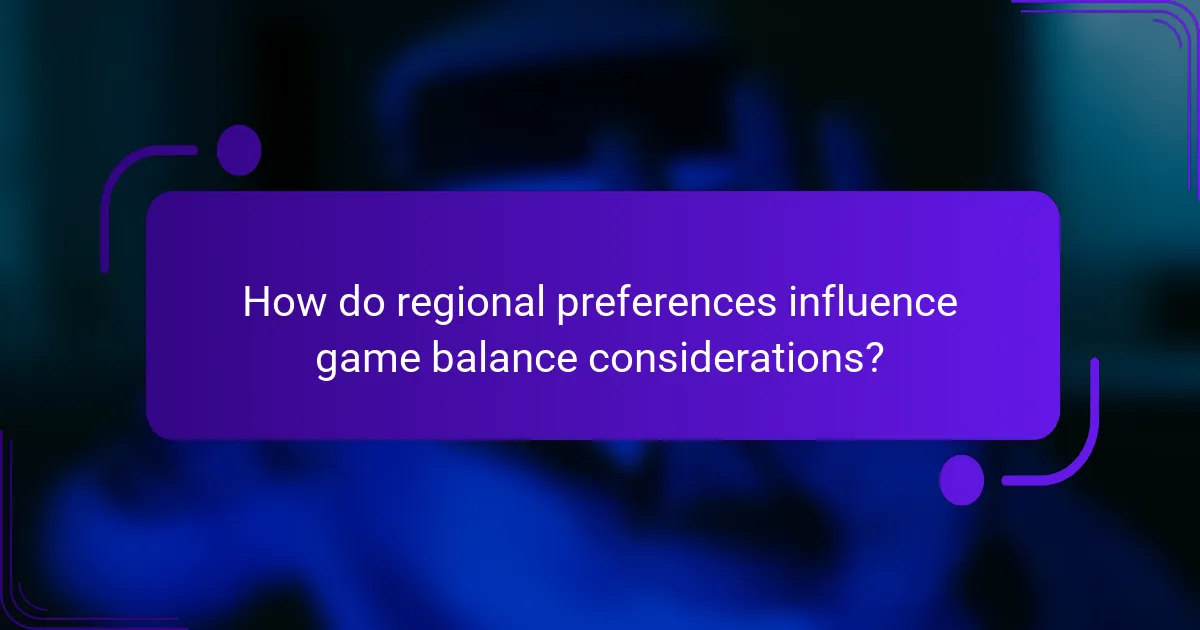Game balance is crucial for fairness and engagement in multiplayer fantasy adventure games. Key considerations include character diversity, resource allocation, and skill scaling. Different player roles impact gameplay dynamics and strategies. Regular updates and regional preferences also play a significant role in maintaining balance and enhancing player experience.

What are the key principles of game balance in multiplayer fantasy adventure games?
Game balance in multiplayer fantasy adventure games focuses on fairness, player engagement, and strategic depth. Key principles include character diversity, resource allocation, and skill scaling.
Character diversity ensures varied playstyles, allowing players to choose roles that complement team dynamics. Resource allocation maintains competition by balancing rewards and penalties, preventing any player from becoming overwhelmingly powerful. Skill scaling adjusts abilities based on player performance, promoting skill development and rewarding mastery.
These principles create an engaging environment, encouraging teamwork and enhancing the overall gaming experience.
How does player skill level impact game balance?
Player skill level significantly impacts game balance by influencing competition and player experience. High-skilled players can dominate, potentially discouraging newcomers. Developers often implement matchmaking systems to pair players of similar skill levels, enhancing fairness. Additionally, game mechanics may be adjusted to ensure that skill disparities do not overly skew outcomes. This balance is crucial for maintaining player engagement and satisfaction in multiplayer fantasy adventure games.
Why is character diversity important for balance?
Character diversity is crucial for balance in multiplayer fantasy adventure games as it promotes varied playstyles and strategies. Diverse characters enhance gameplay by catering to different player preferences, ensuring no single character dominates. This balance fosters a more engaging and competitive environment, allowing players to explore unique abilities and tactics. As a result, games become more enjoyable and replayable, attracting a broader audience.
Which mechanics contribute to a fair competitive environment?
Game balance in multiplayer fantasy adventure games relies on mechanics that ensure fairness and competitiveness. Key mechanics include character class balance, skill scaling, matchmaking systems, and resource distribution.
Character class balance ensures no single class dominates gameplay, promoting diverse strategies. Skill scaling adjusts abilities to maintain competitiveness across player levels. Matchmaking systems pair players of similar skill levels, enhancing challenge and enjoyment. Resource distribution prevents monopolization of in-game assets, fostering equitable gameplay experiences.
These mechanics collectively contribute to a fair competitive environment, enhancing player engagement and satisfaction.

How do different player roles affect game balance?
Different player roles significantly impact game balance by influencing gameplay dynamics and interactions. Each role contributes unique strengths and weaknesses that can either complement or counterbalance others, shaping overall game strategy. For example, a tank role absorbs damage and protects teammates, while a damage dealer focuses on offense, creating a dynamic where teamwork is essential. This interplay can enhance or disrupt balance, depending on how well roles are designed and integrated. Ensuring that each role is viable and has distinct contributions is crucial for maintaining a fair and engaging gaming experience.
What are the implications of tank, healer, and damage dealer roles?
Tank, healer, and damage dealer roles significantly impact game balance in multiplayer fantasy adventure games. Tanks absorb damage, healers restore health, and damage dealers focus on dealing damage. Each role influences team dynamics, strategy, and player experience.
Balancing these roles ensures that no single role dominates gameplay. For example, if tanks are too powerful, matches may become one-sided, reducing engagement. Conversely, if damage dealers are overly effective, it can lead to quick defeats, frustrating players.
Effective role distribution fosters teamwork and enhances the overall game experience. Players must collaborate to maximize their strengths, creating a more dynamic and enjoyable environment. This balance encourages diverse strategies and keeps gameplay fresh.
Developers often analyze player feedback and performance metrics to adjust these roles. Continuous updates help maintain equilibrium, ensuring that each role remains relevant and impactful in the game.
How can role synergy enhance or disrupt balance?
Role synergy can enhance balance by promoting teamwork and strategy, but it can also disrupt balance through overpowered combinations. Effective role synergy allows players to complement each other’s abilities, creating a more dynamic gameplay experience. For instance, a healer supporting a tank can lead to sustained team presence in battles. Conversely, if certain roles dominate, such as a highly coordinated damage-dealing group, it can skew game balance and reduce overall enjoyment. Developers must monitor these dynamics to ensure a fair and engaging environment for all players.

What metrics are used to assess game balance?
Game balance in multiplayer fantasy adventure games is assessed using metrics like win rates, player feedback, and character performance. These metrics help identify imbalances that may affect gameplay enjoyment and competitiveness.
1. Win rates: Analyze the frequency of victories for various characters or classes to spot dominance.
2. Player feedback: Gather qualitative data from players to understand perceived fairness and enjoyment.
3. Character performance: Measure attributes like damage output, healing efficiency, and survivability to evaluate balance.
4. Match duration: Assess how long matches last to determine if certain strategies are overly effective.
5. Usage rates: Track how often players select specific characters or abilities to identify potential overpowered elements.
6. Meta shifts: Monitor changes in popular strategies and character choices over time to adapt balance accordingly.
How do win/loss ratios inform balance adjustments?
Win/loss ratios are critical for adjusting game balance in multiplayer fantasy adventure games. They provide insights into player performance and highlight potential imbalances in character abilities or game mechanics.
Analyzing these ratios helps developers identify which characters or strategies dominate the gameplay. For example, if a specific character has a significantly higher win ratio, adjustments may be necessary to ensure fairness. Conversely, characters with low win ratios may require boosts to enhance their effectiveness.
Regular monitoring of win/loss ratios allows developers to make informed decisions about balance changes, ensuring a more engaging and competitive experience for players. This data-driven approach fosters a dynamic game environment where all players can thrive.
Why is player feedback crucial in evaluating balance?
Player feedback is essential for evaluating balance as it provides insights into gameplay experiences. This feedback reveals player perceptions of fairness, challenge, and enjoyment, directly impacting game design decisions. Analyzing player comments helps identify overpowered or underpowered elements, ensuring a more engaging experience. Additionally, player feedback fosters community involvement, enhancing game longevity and player satisfaction.

What unique challenges arise in balancing PvP versus PvE gameplay?
Balancing PvP and PvE gameplay presents unique challenges, primarily due to differing player motivations. PvP players seek competitive advantage, while PvE players prioritize narrative and exploration.
Game developers must ensure that enhancements for PvP do not disrupt PvE experiences, as this can alienate players. For instance, overpowered PvP gear may lead to frustration in PvE scenarios, diminishing the enjoyment of cooperative gameplay.
Additionally, balancing rewards is crucial. PvP rewards need to feel meaningful without overshadowing the achievements in PvE. This balance fosters a healthy community where both play styles coexist harmoniously.
Finally, frequent updates are necessary to address imbalances. Player feedback is vital in maintaining equilibrium and ensuring that both PvP and PvE elements remain engaging and fair for all participants.
How do difficulty scaling and enemy AI affect balance?
Difficulty scaling and enemy AI significantly influence game balance in multiplayer fantasy adventure games by adjusting challenge levels and player engagement. Difficulty scaling ensures that players face appropriate challenges relative to their skill levels, enhancing enjoyment and competitiveness. Effective enemy AI adapts to player strategies, creating dynamic encounters that require players to think critically and adjust their tactics.
When difficulty scaling is too harsh or too lenient, it can lead to frustration or boredom. Balanced enemy AI should provide a fair challenge without being overwhelming, ensuring that players feel accomplished. Additionally, unique attributes of enemy AI, such as learning from player actions, can create a more immersive experience, requiring players to continuously adapt.
Overall, careful integration of difficulty scaling and AI behavior is essential for maintaining balance, ensuring that players remain engaged and motivated throughout their gaming experience.
What strategies can be employed to maintain fairness in PvP?
To maintain fairness in PvP, implement balanced mechanics and regular updates. Ensuring equal opportunities for all players is crucial.
1. Adjust character abilities to prevent overpowered builds.
2. Monitor win rates and player feedback to identify imbalances.
3. Introduce skill-based matchmaking to pair players of similar abilities.
4. Regularly update content to refresh strategies and counteract stale gameplay.
5. Encourage community input on balance changes to foster engagement.

How do regional preferences influence game balance considerations?
Regional preferences significantly influence game balance considerations by shaping player expectations and gameplay experiences. Different cultures may favor specific play styles, character classes, or narrative elements, requiring developers to adjust mechanics accordingly. For example, in some regions, cooperative gameplay may be more popular, necessitating a focus on team dynamics and synergy among characters. As a result, balancing combat effectiveness and character abilities must account for these preferences to ensure fairness and enjoyment across diverse player bases. Moreover, regional feedback can highlight unique attributes, such as preferred difficulty levels or engagement strategies, guiding developers in creating a more inclusive gaming environment.
What cultural factors shape player expectations in multiplayer games?
Cultural factors significantly shape player expectations in multiplayer fantasy adventure games. These factors include regional storytelling traditions, community engagement, and social norms around competition and cooperation.
Players from different cultures may expect varying game mechanics, narrative depth, and character development based on their cultural backgrounds. For example, players from collectivist cultures may prioritize teamwork and collaboration, while those from individualistic cultures may focus on personal achievement and competition.
Additionally, cultural familiarity with fantasy themes influences players’ expectations regarding game balance. Players may prefer certain character archetypes or magical systems that resonate with their cultural narratives.
Understanding these cultural influences helps developers create more engaging and inclusive gaming experiences that align with diverse player expectations.
How do popular game formats differ across regions?
Game formats in multiplayer fantasy adventure games vary significantly across regions due to cultural preferences and gameplay expectations. For instance, Western audiences often favor open-world exploration and detailed narratives, while Asian markets may prioritize competitive elements and fast-paced action.
In North America, there is a strong emphasis on cooperative gameplay and character customization, which enhances player engagement. Conversely, in Europe, strategy and tactical elements are more pronounced, leading to a focus on resource management and team dynamics.
Asian markets, particularly in Japan and South Korea, highlight mobile gaming formats that cater to quick sessions and social interaction, reflecting local gaming habits. This regional diversity shapes how game developers approach balance and design, ensuring that gameplay resonates with the target audience.

What are the rare attributes that can enhance game balance?
Rare attributes that can enhance game balance include unique character abilities, environmental interactions, dynamic scaling of difficulty, player-driven economy impacts, and asymmetrical faction strengths. These elements contribute to a more engaging and balanced gameplay experience, fostering strategic diversity among players.
How do unique game mechanics create a balanced experience?
Unique game mechanics foster balance by ensuring diverse strategies and player interactions. These mechanics introduce varied gameplay elements that require players to adapt, promoting fairness and engagement. For instance, asymmetric abilities can create unique strengths while maintaining overall game equilibrium. Additionally, mechanics like resource management and skill progression enhance competitiveness, allowing players to leverage their unique attributes effectively. This balance encourages collaboration and strategic depth, enriching the multiplayer experience in fantasy adventure games.
What lessons can be learned from niche games with innovative balance solutions?
Niche games with innovative balance solutions teach valuable lessons about player engagement and fairness. They often utilize unique attributes, such as dynamic difficulty adjustment, to enhance gameplay experience. Successful examples demonstrate the importance of player feedback in refining balance. Additionally, these games show that diverse character abilities can create a more inclusive environment. Emphasizing cooperative play can foster teamwork and enjoyment, leading to longer player retention. Finally, incorporating player-driven economies can add depth, encouraging strategic thinking and interaction among players.

What are the best practices for maintaining game balance post-launch?
To maintain game balance post-launch, developers should regularly analyze player data, adjust character abilities, and implement player feedback. Continuous monitoring ensures that no single strategy dominates gameplay.
1. Analyze player performance metrics to identify imbalances.
2. Adjust character abilities based on usage rates and win ratios.
3. Gather and implement player feedback through surveys and forums.
4. Monitor game updates for unintended consequences on balance.
5. Schedule regular balance patches to address emerging issues.
How can developers effectively implement balance patches?
Developers can effectively implement balance patches by analyzing player feedback, monitoring game metrics, and adjusting character abilities. Regular updates ensure the game remains fair and engaging. Communication with the player community is essential for transparency and trust. Testing changes in a controlled environment helps prevent unintended consequences. Balancing should focus on maintaining the core gameplay experience while addressing any emerging disparities.
What common mistakes should be avoided in game balancing?
To achieve effective game balance in multiplayer fantasy adventure games, avoid common mistakes. These include neglecting player feedback, overcomplicating mechanics, and failing to test extensively.
Ignoring player feedback can lead to imbalances that frustrate users. Overcomplicated mechanics may confuse players, diminishing enjoyment. Insufficient testing can result in unforeseen issues, disrupting gameplay.
Additionally, avoid creating overly powerful characters or items, which can skew balance. Ensure all elements contribute to a fair and engaging experience. Finally, don’t overlook the importance of regular updates to maintain balance as the game evolves.
What expert tips can help sustain long-term balance in multiplayer games?
To sustain long-term balance in multiplayer fantasy adventure games, focus on regular updates, community feedback, and diverse character options. Implementing these strategies helps maintain player engagement and fairness.
1. Regular Updates: Consistently introduce new content and balance changes to keep gameplay fresh and fair.
2. Community Feedback: Actively seek player input to identify balance issues and desired features.
3. Diverse Character Options: Offer a variety of playable characters with unique abilities to enhance strategic gameplay.
4. Performance Metrics: Monitor in-game statistics to identify and address imbalances promptly.